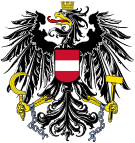| This article is part of a series on the |
| Politics of Austria |
|---|
 |
On the federal level, there are two main elections in Austria: presidential elections and elections to determine the composition of the National Council (Nationalrat), the lower house of Austria's bicameral Parliament. The upper house, the Federal Council consists of delegates from the states and is not directly elected. These elections are governed by federal law, which also applies to European Parliament elections.
Austria's federal president (Bundespraesident) is elected for a six-year term, most recently in 2022 Austrian presidential election. The election takes place under the two-round system to ensure that the president is supported by a majority of the voters. Under this system, a first round of voting is held, and unless one candidate gets a majority there, a second round is held where only the two highest-ranking candidates from the first round are included.
The National Council is elected by proportional representation. Elections take place every five years, except that a snap election may be called if the chancellor wants early elections or loses the support of a majority in the National Council, as happened in 2017 and again in 2019.
Austria has a multi-party system. From 1945 to 1983, Austrian politics had a two-party system, where two main parties, the SPÖ on the center-left and the ÖVP on the center-right, generally dominated politics, and were the only parties to form government, most often forming a grand coalition when neither party had a majority of seats.
Starting in 1983, as the right-wing Freedom Party started to win more seats, the coalitions that emerged depended on whether SPO or OVP was responsible for forming government. If it was SPO, the result was a grand coalition of the two centrist parties. However, if the OVP won the most votes, as it did on five occasions, it had the option of forming a coalition with the far right Freedom Party instead of the centre left SPO. This is what it did in 1983, 1999, 2002 and 2017. Following the 2019 National Council elections, the victorious ÖVP negotiated a coalition agreement with the Green Party instead, bringing the Green Party into the government for the first time.
For a party to be represented in the National Council, it must either pass the threshold of at least 4% of all valid votes cast nationwide, or win one mandate (seat) in one of the regional electoral districts. If a party doesn't satisfy either requirement, it does not participate in the allocation of seats.[1] This threshold exists to discourage parties from splintering and producing an unmanageably large number of small parties in parliament.
In some cases, a national referendum can be called by the Austrian Parliament.
In 2007, the voting age was lowered from 18 to 16 in all federal elections. Some states had already lowered the voting age for state and local election before 2007.
- ^ countriestudies.us - Austrian Electoral System, retrieved 18 May 2010

